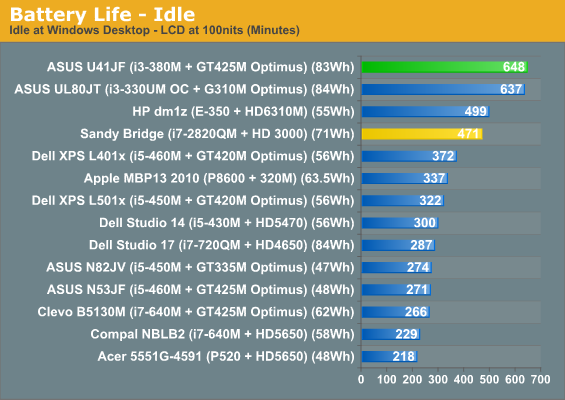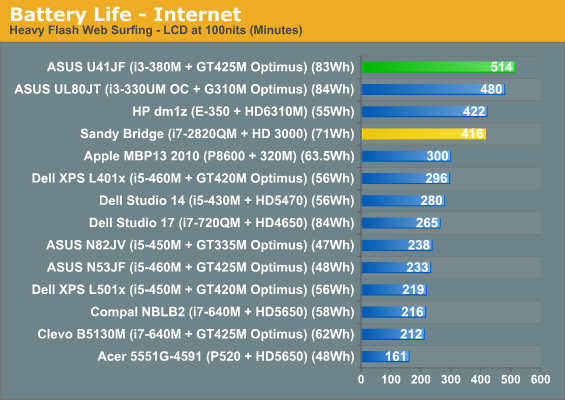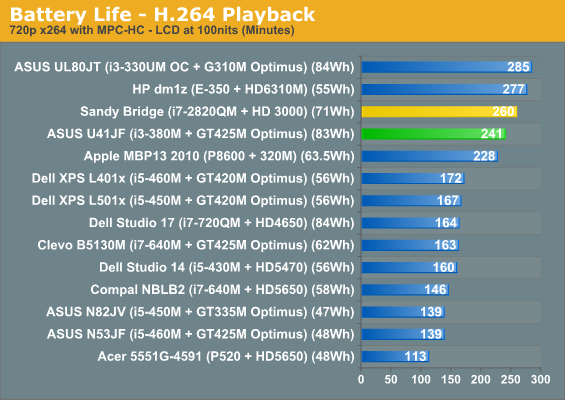ASUS U41JF: Arrandale's Not Dead Yet
by Jarred Walton on March 28, 2011 7:35 PM ESTBattery Life: Capacity Triumphs
There’s simply no beating a higher capacity battery, all other areas being equal. I do find it a bit funny that ASUS has relabeled their battery to be 83Wh now instead of 84Wh; technically it’s still 83.52Wh based on the simple (V*Ah) equation, but then you’re likely going to get a lot less than 83Wh out of it after a few months of use when it’s no longer running at 100%. Anyway, I don’t have much to add here on battery wear levels, as for some reason HWMonitor didn’t pick up the information for this particular laptop.
Looking at the laptop market as a whole, Apple is able to squeeze some amazing battery life out of their laptops with OSX, but install Windows 7 on them and they become merely average. ASUS has been one of the best options for battery life on Windows laptops ever since the debut of their UL series in 2009, and with the U41JF you can now get nearly all of the battery life with improved graphics performance when you want it. Also note that we tested with SHE (i.e. underclocking) enabled; if you choose to run at stock speeds, you’ll get about 10% less battery life.




When you can last over ten hours for basic work, or 8.5 hours of constant Internet surfing, you know you’re doing pretty well. The U41JF actually surpasses the ULV-based UL80JT in two of the three battery life results (with H.264 favoring the UL80JT). Compared to the older U30JC (not shown, but you can see the results in Mobile Bench), it also wins in the Idle and Internet tests, and the H.264 result is a lot closer than the UL80JT. The UL80VT is still our battery life champion, posting over 14 hours in the Idle test, but performance is clearly slower than the latest U- and UL-series laptops.
In keeping with recent tradition, I also tested several other areas of battery life. For an 83Wh battery, the U41JF manages to recharge pretty quickly, taking just over three hours (192 minutes) to go from completely drained to 100% charge. Power draw measured 37-57W while charging, with higher power draw when the battery was closer to dead. If ASUS is like other manufacturers, they have some smarts in their batteries so that they don’t overcharge some cells (and cause them to wear out faster), which would explain the drop in power draw as maximum capacity approached.
Gaming battery life as always is a bit of a stretch. You can run the CPU/GPU pretty much at AC performance levels, but not for all that long. Looping 3DMark03, the battery lasted 145 minutes, which would correlate to a less demanding game. 3DMark06 hits the CPU/GPU more, and battery life drops down to just 102 minutes (think of games like Crysis, Battlefield: Bad Company 2, Metro 2033, etc.) If you want to run the LCD at maximum brightness instead of 100 nits, we measured a rather high increase in power requirements of nearly 5W, so that’s one more item to consider. For most practical scenarios, though, the U41JF will provide an all-day computing experience with no need to find an outlet.











24 Comments
View All Comments
JarredWalton - Tuesday, March 29, 2011 - link
Besides the MacBook Pro? I'm not aware of any right now; most of the high-end displays tend to come in business laptops, and unfortunately business laptops often fail on the graphics side of the equation. Dell's XPS 15 update is still good, but aesthetically lacking and battery life isn't as high as I'd like (review forthcoming). There are still some decent 1080p 15.6" panels around, but if you're looking for something in the 13-14" range I'm currently at a loss. :-(Hrel - Wednesday, March 30, 2011 - link
I'd actually consider buying this if it had a decent 1080p screen:( Something around as good as the one Compal used in their 15.6" laptop with the GT425m.Jarred: I do think you'll be interested to hear that there IS a laptop with a 1080p screen in a 15.6" chassis for as low as 526 dollars on Cyberpowerpc.com right now. I don't know the specs or contrast or anything like that, but it's a laptop with Sandy Bridge and no dedicated GPU that does however offer a 1080p screen for 526 bucks. Start upgrading things and the price goes up but you could still get one hell of a laptop for 700 bucks really easily.
I would LOVE to see how that screen stacks up against the bog standard we're bombarded with. Please do everything you can to get one of those in house configured however you want, preferably with a 2nd Gen i3 or i5 (we've already seen i7 performance plenty) in it.
JarredWalton - Wednesday, March 30, 2011 - link
The inexpensive Xplorer-9200 probably uses a display much like the 1080p model in the ASUS N53 we looked at a couple months ago; the Xplorer-9300 (Clevo P151HM) on the other hand is probably a decent panel, but it costs a lot more. Anyway, I sent them an email so we'll see if they want to send us some review hardware.fokka - Saturday, April 2, 2011 - link
"If ASUS is like other manufacturers, they have some smarts in their batteries so that they don’t overcharge some cells (and cause them to wear out faster), which would explain the drop in power draw as maximum capacity approached."afaik all lion and lipo batteries consisting of more than 1 cell have to be balanced. thats why batteries not only come with two poles, positive and negative, but also with a few extra poles, depending on the cell-count. so every cell can be charged and discharged to the exact same voltage (only differences up to ~0.02v are acceptable).
i know this because i recently upgraded my rc-car to lipo-batteries and needed a new charger with balancer for that matter.
so now you know ;)